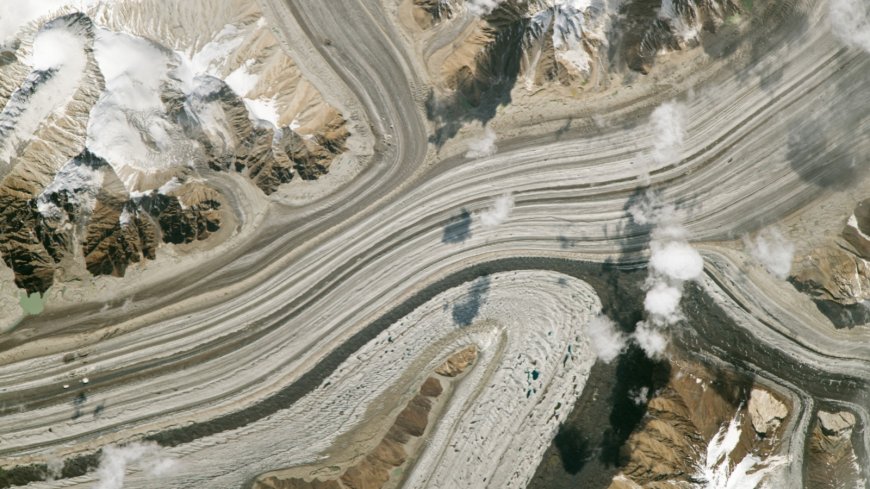Stripy Glaciers Merging in Central Asia: An Anomaly in Earth's Highest Battleground
Astronaut photo captures three stripy glaciers merging in the Karakoram mountain range, defying global ice loss trends. Located in a disputed territory claimed by India and Pakistan, these glaciers are part of the 'Karakoram anomaly' that puzzles scientists.

An unnamed astronaut on board the ISS snapped this striking shot of striated glaciers merging into a single ice mass in the Karakoram mountain range.
QUICK FACTS
Where is it? Karakoram mountain range, Kashmir region, central Asia 35.50982304, 76.99307626
What's in the photo? Three striated glaciers merging into a single ice mass
Who took the photo? An unnamed astronaut on board the International Space Station
When was it taken? Aug. 15, 2023
This intriguing astronaut photo shows a trio of \"anomalous\" ice masses merging in the heart of central Asia. The stripy glaciers are bucking a global trend by gaining volume, despite the effects of human-caused climate change.
The aerial image shows the Lolofond glacier (top) and Teram Shehr glacier (bottom) merging with the Siachen glacier (center), along with a smaller unnamed tributary glacier. The ice masses are located in the Karakoram mountain range, a largely uninhabited area situated alongside the Himalayas in the Kashmir region, where the borders of India, Pakistan, China, Afghanistan and Tajikistan meet.
Siachen is Earth's second-longest glacier outside of Greenland and Antarctica, and is around 47 miles (76 kilometers) long and 2.2 miles (3.5 km) across at its widest point, according to NASA's Earth Observatory. The glacier starts around 19,000 feet (5,800 meters) above sea level, while its end, or terminus, sits at an altitude of around 11,800 feet (3,600 m).
Each of the glaciers in the photo is made up of parallel striations, or lines, known as moraines, which are folds of ice rich in dust and rock that get trapped in between merging glaciers, according to the National Park Service. There is a particularly thick and dark moraine where Teram Shehr and the smaller unnamed glacier merge with Siachen.
Eagle-eyed readers may be able to spot some other unusual features in the image, including a green-hued lake and two large chunks of white ice trapped in a moraine within Siachen (both located near the far left of the photo).
Unlike most of Earth's glaciers, which are rapidly losing their ice as a result of climate change, the Karakoram glaciers have expanded slightly in volume over recent decades. \"These gains — known as the 'Karakoram anomaly' — are yet to be fully explained, and scientists question how long they will persist,\" Earth Observatory representatives wrote.
Some researchers believe that the anomaly can be explained by local weather patterns, while others argue that the dust and dirt in the glaciers' moraines help to insulate the ice from warming temperatures, according to the National Snow and Ice Data Center. Neither explanation is fully accepted by the scientific community.
Siachen is disputed territory, claimed by both India and Pakistan. Both countries have had a military presence near the glacier's summit since 1984 and have clashed on multiple occasions. As a result, the Siachen glacier holds the title of Earth's highest battleground, according to Guinness World Records (GWR).
Around 2,000 soldiers have died during the conflict, but almost all of them were killed by \"extreme weather conditions,\" according to GWR.
According to the source: Live Science.
What's Your Reaction?
 Like
0
Like
0
 Dislike
0
Dislike
0
 Love
0
Love
0
 Funny
0
Funny
0
 Angry
0
Angry
0
 Sad
0
Sad
0
 Wow
0
Wow
0

























































































































































































